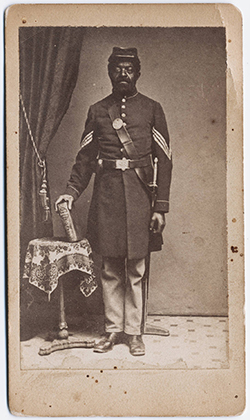
Please send all Checks and Money orders to :
Dave Taylor P.O. Box 87 Sylvania, OH 43560
419-842-1863
Click Here to E-mail Us!
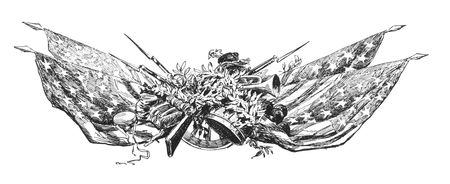
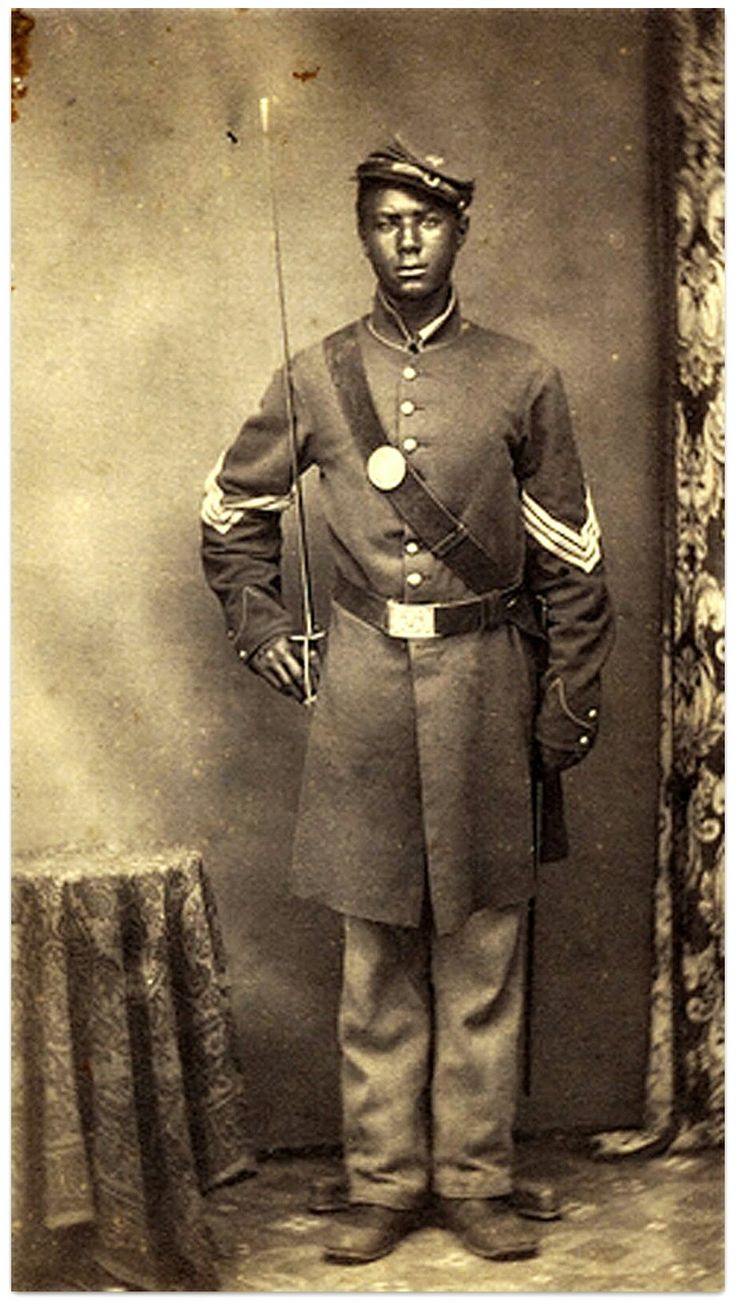
17-10-02
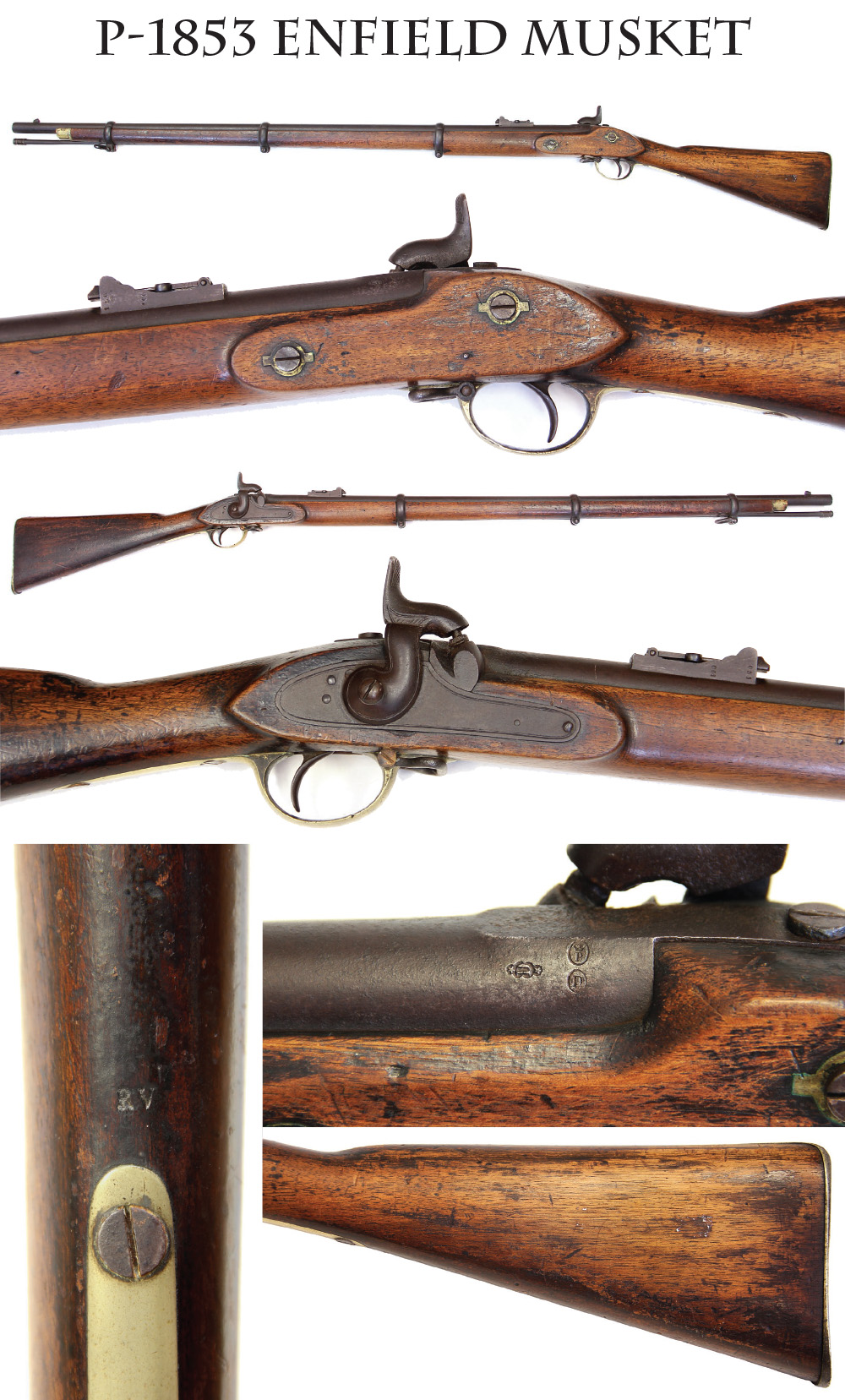
17-10-15… Extremely Rare French Contract P-1853 Enfield Rifle Musket:
In the forty five years I have collected and traded antique guns, this is the first of these unsigned French Enfields I have owned. Classic P1853 Enfield in overall VG ++ condition. The barrel has many interesting proof marks including a cartouched “D” flanked by two five pointed stars, a crown over P, and letter D inside a vertical oval. A truly top quality contract piece made in France under contract. Rear sight has a crown over F. The underside of the stock is stamped RV in front of the trigger guard tang. 100% original, 100% complete, and mechanically perfect. These French Enfields were used in the Crimean War (1854-1856), and with France’s close ties to the Confederacy they have a Southern connection as well. A very solid Enfield and darn scarce… $1,495.00 Sold
Call us @ 419-842-1863
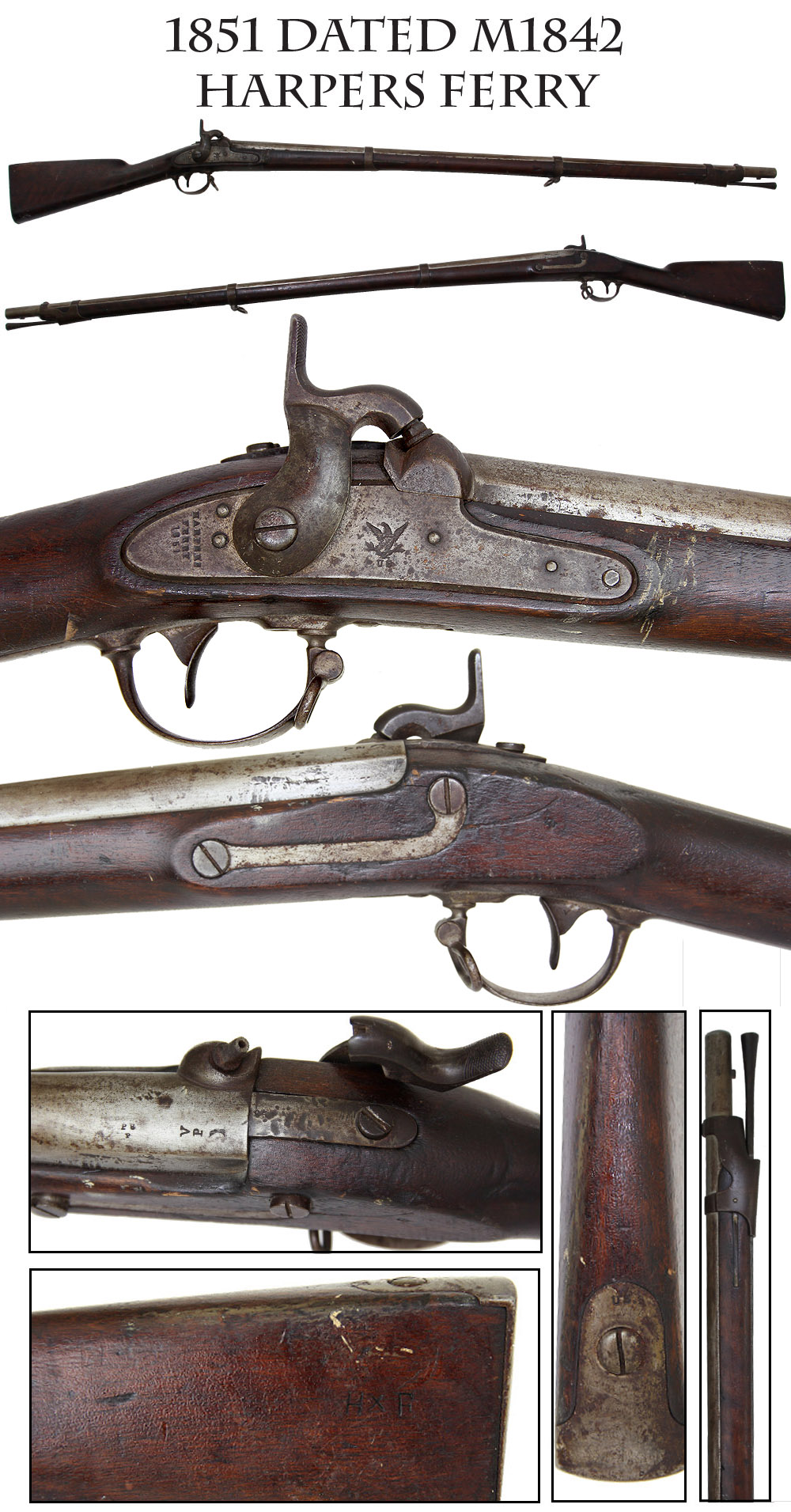
17-10-16 … 1851 Dated M1842 Harpers Ferry Virginia Musket: Harpers Ferry guns are always in demand because of their strong connection with the South. They were made in Virginia, and the Confederates captured the Arsenal early in the war and took all the weapons on hand as well as the machinery. This one has a very clear Harpers Ferry eagle over a US forward of the hammer and Harpers Ferry 1851 in three lines aft of the hammer. V/P/eaglehead barrel proofs are very clear at the left breech along with barrel inspector initials just forward of that. Barrel tang has “185-” visible… last digit of the date not legible but presumably a “1”. A few dings on top of the tang. Good action. Nice delicate patina overall with the barrel being less patinated and more gun metal grey. Some very slight rounding to the wood edges of the lock platform and the offside. No cartouches visible. A few abrasion marks and light dings, and a couple of paint spots that will come off from storage in someone’s garage. Bolster and lock show mostly dull silver and pewter. A small set of initials, “HxF” scratched in the upper butt flat near the butt plate tang, and what looks like a backwards “S” is stamped in the cartouche area. All bands, springs, swivels, rod and bayonet stud in place. A very respectable example at a livable price … Sold
Call us @ 419-842-1863
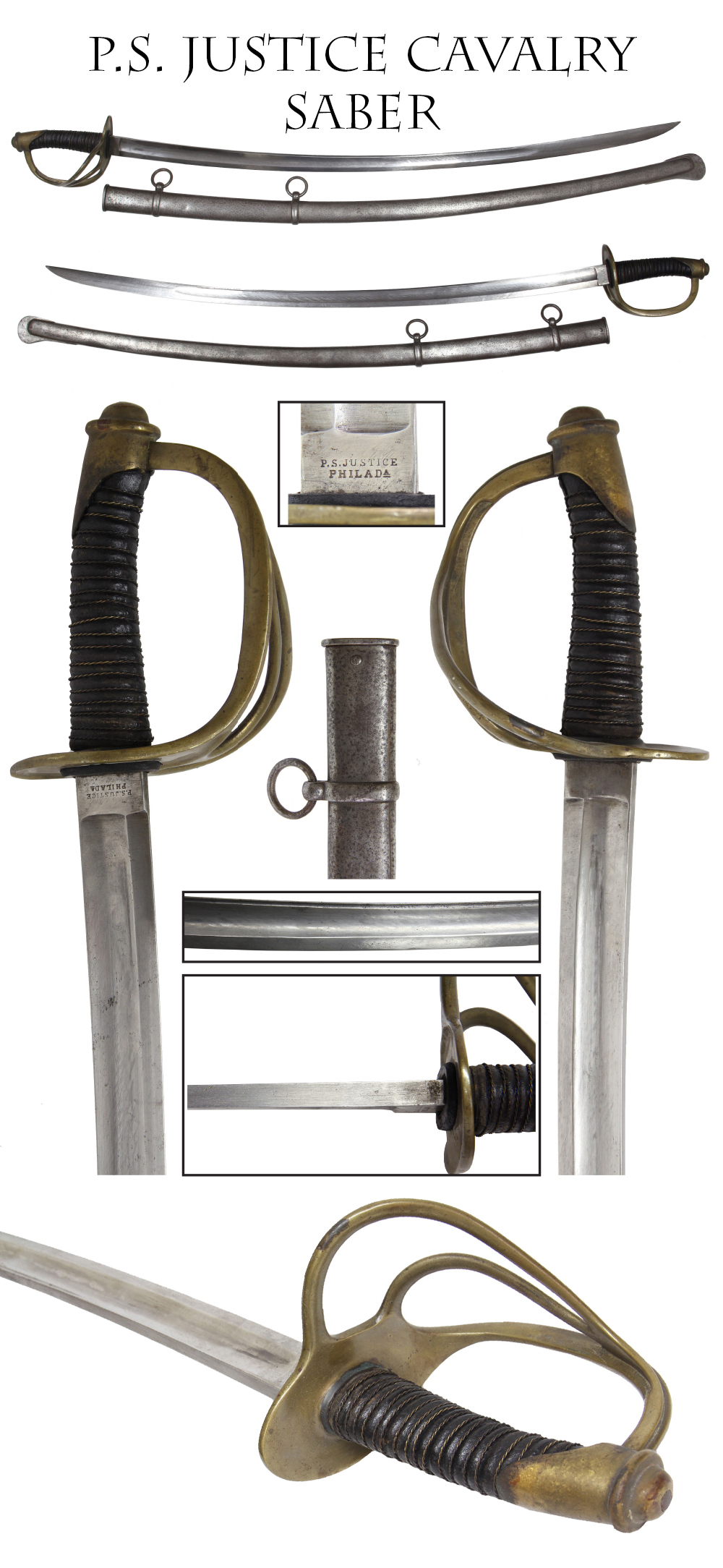
17-10-17 P.S. JUSTICE PHILADELPHIA CAVALRY SABER…
Model1840 US heavy cavalry saber by P.S. Justice of Philadelphia. Crisp markings at ricasso, clean blade in the bright with good edge and point. Mellow age patina to the brass guard. Original leather and wire with just slight rubbing to the leather. Twisted wire is original and has one repair to a break. Blade bumper pad still in place below hilt. Scabbard is a mix of silver and gray with some brown spotting. Throat, drag and carrying rings are firmly in place. Federal cavalry carried a mix of 1840 and 1860 pattern sabers by various makers. Justice is one the better known military goods suppliers, and a big name amongst Philadelphia arms makers. His markings show up on bayonets, sabers and firearms, but all his products are on the “scarce” side. A nice example priced very friendly.
$675.00 Sold
Call us @ 419-842-1863
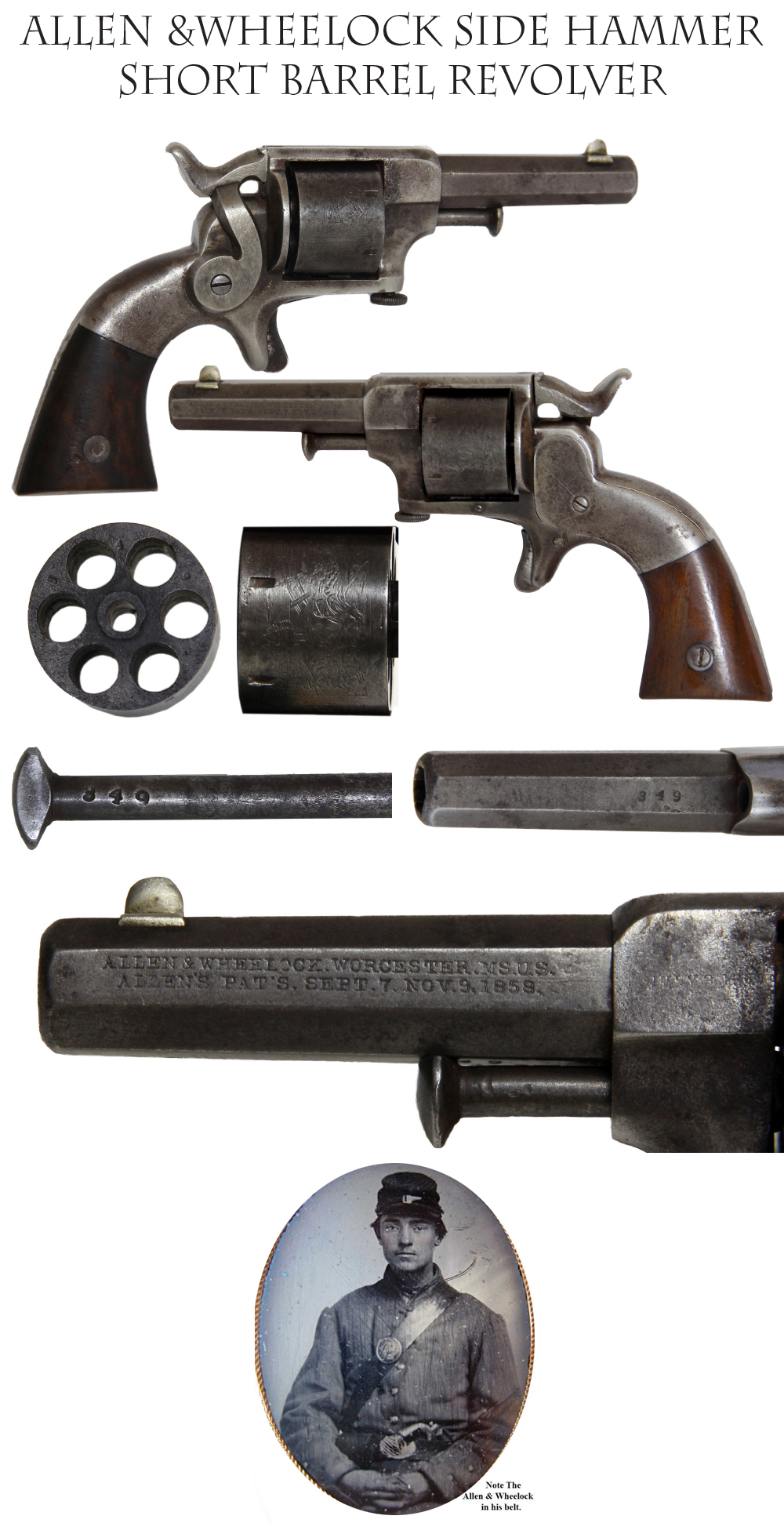
17-10-18 …ALLEN AND WHEELOCK SHORT BARREL SIDE HAMMER REVOLVER …
Ive always liked side hammer revolvers. They are a nice mix old and new styles, though gunsmiths apparently preferred them as easier to work on. This is a nice example of the .32 rimfire side hammer made by Allen and Wheelock from about 1859 to 1862. There were only something over a thousand made, but there were several types and a number of variations. This fits the second model in having a mortised front sight and a July 3, 1860 date partially visible forward of the cylinder, but with the first type button headed cylinder pin. The barrel measures 3 inches. Overall length about 7 inches. The grips are excellent. The metal is an even silver gray overall with some light pitting just forward of the cylinder, likely from the discharge of the gun. The cylinder itself keeps some of its color and the cylinder scene of dogs chasing a rabbit is visible, which is uncommon since it was lightly rolled. The 1858 patent stamp is sharp on the left barrel flat, but the July 3, 1860 stamp is obscured by the pitting from firing. The German silver front sight is in place. The ejector rod and barrel showing matching bench number 349. Overall VG cond. Cocks and indexes has a hair trigger. Priced like a gift $425.00 Sold
Call us @ 419-842-1863

17-10-19… SMALL HOLSTER FOR ALLEN & WHEELOCK .32 CALIBER SIDE HAMMER REVOLVER:
A reall smart little belt holster with full, pointed flap pierced for the finial and a narrow belt loop secured with a rivet at the bottom. Nice finish to the leather. Tooled edge on the flap. The edge of the flap has six decorative circular “punches”… one of which was punched through. Fits an Allen and Wheelock .32 caliber side hammer revolver with 3.5 inch barrel perfectly. The holster is solid and the toe plug is in place. The sewn seam shows a careful repair along the edge. Perfect to display with officer’s effects. $450.00
Call us @ 419-842-1863

17-10-20… US COLORED TROOPS RELATED 4th Mass Cavalry Presentation Sword …
Iron hilted US import saber by Clauberg of Solingen in the style of the British 1823 pattern with a backstrap, knucklebow and two outboard branches, and a small inboard loop on the counterguard. “W. Clauberg” over a standing knight, over “Solingen” on the ricasso. Blade is nice, with good edge and point, and with visible etched panels: a “US” amid floral scrolls on one side and an American eagle with an “E Pluribus Unum” ribband on the other side. Blade overall shows a dull silver mixed with bright. Nicely engraved in a flowing script on the scabbard beneath the throat is: “Presented/ Lieut. Benj. Thomas / 4th Mass. Cavl. By the Phoenix Club” The Phoenix Club was a social club in Hingham, Mass., formed first in 1849 that adopted that title in 1856. It was largely engaged in organizing sociable, fancy dress-balls and 4th of July parades. The 4th Mass Cavalry was organized in February, 1864, by combining a battalion of the 1st Mass Cavalry with two other battalions formed in February and April. The battalions operated largely on their own during the war. Company C was part of the 2nd Battalion commanded by Major Keith and was sent to Hilton Head, where it took part in an expedition up the Ashepoo River in May. Two of the companies were then sent to Florida, where they were active in a number of expeditions and skirmishes, as were the two that remained on Hilton Head. The regiment lost 4 officers and 28 enlisted men killed or mortally wounded in their engagements. Thomas was from Hingham, Mass. and enlisted 12/17/63 as a Second Lieutenant and was commissioned in Co. C on 1/6/64. On 2/1/64 he was promoted to First Lieutenant and Quartermaster, which indicates he had some education and talent for organization. At some point he was even promoted to Acting Assistant Quartermaster for the Tenth Army Corps. He served through 12/9/64 and after the war he was a member of G.A.R. Post 29 in Waltham, Mass. He supplied a memoir of his service to the town’s history its service in the Civil War: In November, 1863, Lieut. Thomas received an appointment as recruiting-officer; and, in the following December, was commissioned second lieutenant. Located at the time in Boston, he continued the work of enlistment; and, being quite successful, was commissioned Jan. 1, 1864, as first lieutenant, and assigned to the Fourth Mass. Cavalry as quartermaster. In April, 1864, with the regiment, was ordered to report to Gen. Gilmore, then in command of the Department of the South, with headquarters at Hilton Head, and three days after again embarked under orders to report at Fortress Monroe. His next destination was City Point, for the purpose of co-operating, under Gen. Butler, with all the armies of Virginia, in the “on to Richmond” movement of that year. Being the advance guard to City Point, the duties were numerous and the labor severe. Thomas, as quartermaster, was required to be constantly on the move. Besides being responsible for the supply of rations for men and horses, and other material for the general prosecution of the war, a further duty was imposed as “ordnance officer,” by appointment of the colonel commanding. Soon after there came an acceptable change, in being detailed as A. A. Q. M. of the Tenth Army Corps, under Gen. Terry. Here he continued his labors until, by order of Gen. Butler, the corps was disintegrated, and united with others. Following this movement, Lieutenant Thomas, with other staff officers, was ordered to report to Gen. Weitzel, who had just been placed in command of the Twenty-fifth Corps, composed of twenty-five thousand colored troops. Some disaffection was created with respect to the classing of white troops with colored. Thomas affirms, that, during his entire experience, he found neither better nor braver men than the colored troops. In November and December of 1864, he aided in fitting out the noted Fort Fisher expedition under Gen. Butler, the result of which is well known. At the close of the year, he resigned on account of repeated domestic affliction. He retired from the service, having performed all and more of his complex and often perplexing duties. This is a nicely engraved presentation sword carried by an officer in a post that did not carry a lot of glory but immense responsibility. Inscribed cavalry officer’s sabers to cavalry officers are pretty darn scarce. $2,650.00
Call us @ 419-842-1863
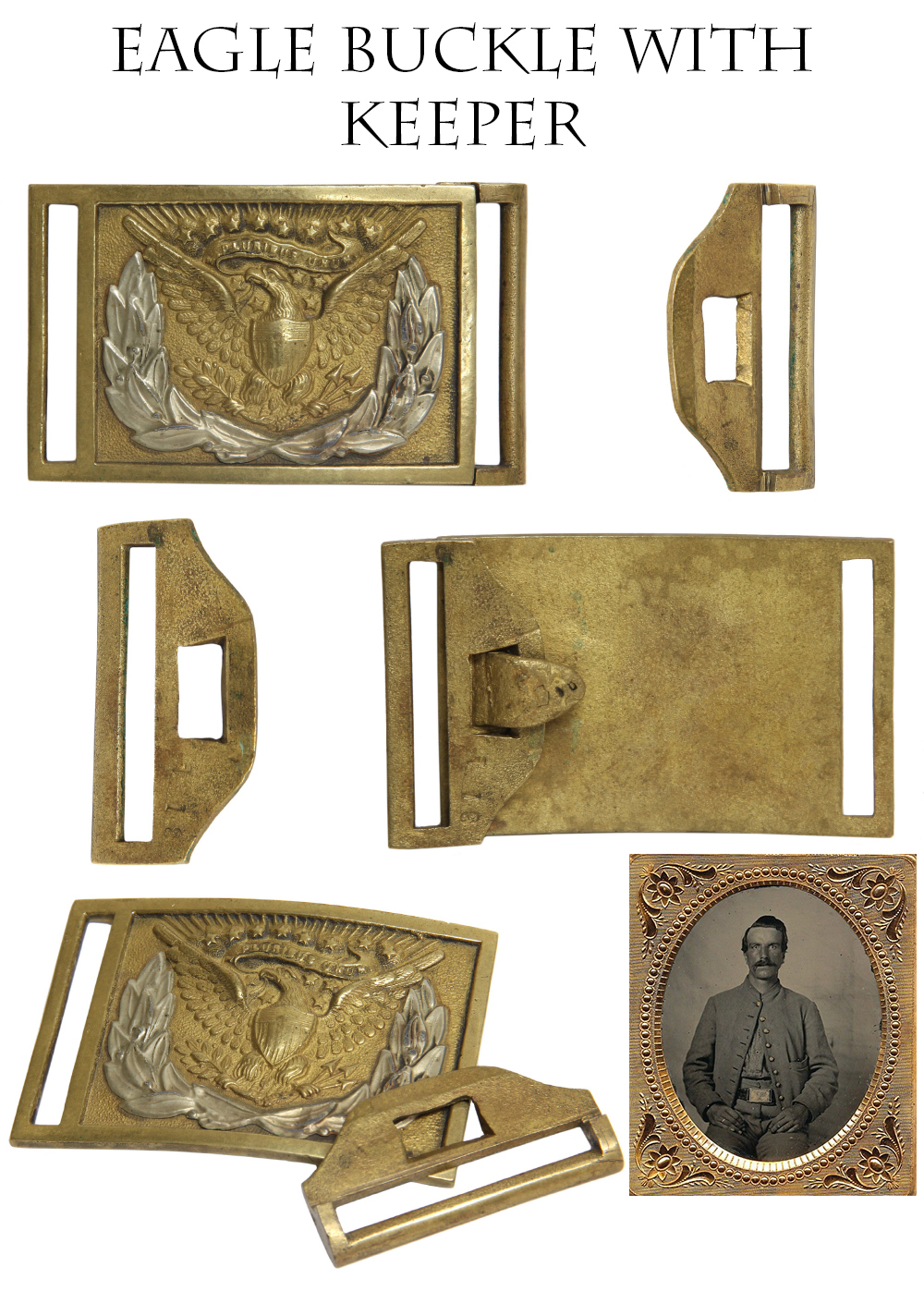
17-10-21 ATTRACTIVE EAGLE BUCKLE WITH KEEPER … Nice early to mid-war example of the regulation 1851 pattern sword belt plate issued to cavalry, artillery and non-commissioned officers. This is the one-piece applied wreath pattern that took the place of the three-piece wreath, but this one was made without the sunrays extending all the way around the eagle as seen on the later CW plates. It was worn on the earlier, slightly narrower sword belt circa 1861 – 1862. This comes with the matching original keeper that fits around the tongue. Both pieces bear the same bench number 311. A really nice example of the regulation US issue sword belt plate. Solid enough to wear should you so desire. Hard to find with the matching keeper…. $325.00 Sold
Call us @ 419-842-1863

17-10-22…EAGLE BREAST PLATE … This is the standard infantry insignia worn by Union soldiers on their cartridge box slings. It was originally designated as the “1828 pattern” circular shoulder belt plate… now referred to as the eagle breast plate. Originally having prongs, they were used as buckles on the early bayonet belts. These plates were switched to the cartridge box sling when the bayonet was moved to the waistbelt. These remained regulation right to the end of the Civil War. This one is in great condition, having been kept clean for its entire life. Looks like it did when it was issued to Billy Yank. The lead back is smooth and flat, with very little corrosion and the iron loops are in place and solid. A very eye-catching example of a regulation accoutrement plate and a basic piece in a Civil War collection. Fairly priced. $195.00 Sold
Call us @ 419-842-1863
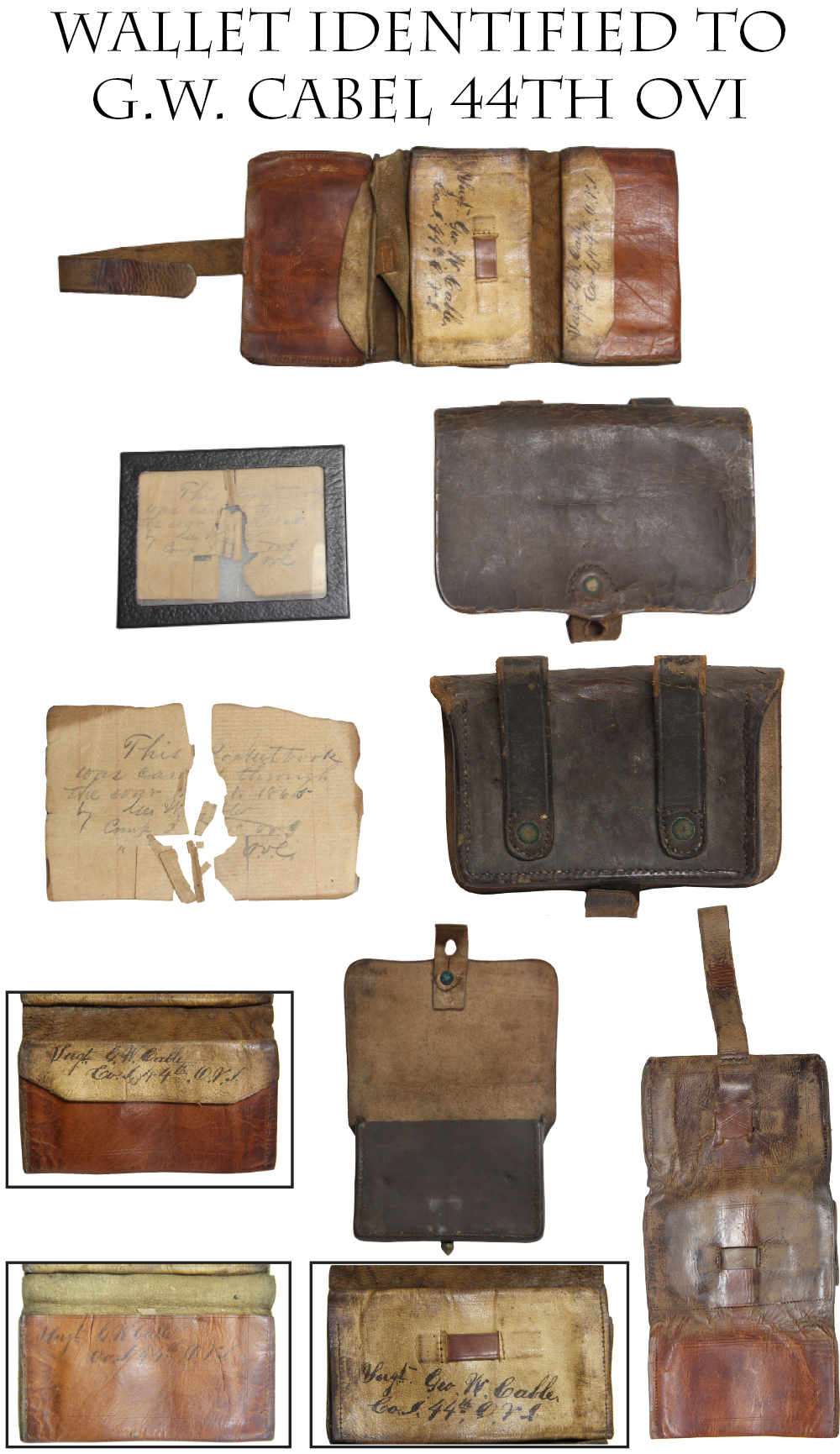
17-10-23….WONDERFULLY IDENTIFIED OHIO SERGEANT’S WALLET AND CARTRIDGE BOX … Nice little identified grouping saved for posterity. A small, three compartment folding leather wallet, fastened by a strap and flat loop, with great period pen inscriptions in three places reading: “Sergt. Geo. W. Cable / Co. I 44th O.V.I.” The regiment had an interesting history, being recruited and serving first as infantry and then converting to cavalry at the beginning of 1864. Together with the wallet is Cable’s cavalry pistol cartridge box from his later service, in very good condition, with both belt loops and latch tab in place, with just some cracks to the finish from flexing and use around the perimeter of the outer flap. With these two pieces is a torn but mostly complete and legible period pencil note: “This pocket book / was car[ried] through / the war [1861] to 1865 / by Geo. W. [Cab]le / Comp. I [44th] O.V.I / Comp. (indicated by ditto marks) […] O.V.C. Cable had a full war history. He enlisted at age 21 on 10/9/61 and mustered in as a sergeant the same day in Company I of the 44th Ohio, and made First Sergeant 7/28/62. The regiment served in West Virginia and Kentucky, suffering casualties on about a dozen occasions, including Lewisburg and Dutton’s Hill. At the end of 1863 a large number of the men reenlisted and the regiment converted to cavalry and was redesignated the 8th Ohio Cavalry and continued its service in West Virginia and in the Shenandoah Valley. Cable must have been well regarded: he received a commission as Second Lieutenant to date 4/20/64 and First Lieutenant of Co. A 5/9/64, and he is recorded as commanding Co. A from March 1, 1865 to July 30, when they mustered out. He also received a commission as Captain dating July 8, but was discharged before being mustered in at that rank. During this period the regiment saw very active service, part of it serving in West Virginia and part in the Shenandoah, including many small engagements with guerillas and small forces, but seeing action at larger fights such as Martinsburg and Winchester. CW data lists 32 instances occasions when they took casualties and Fox records them losing 3 officers and 53 enlistedmen killed or mortally wounded, which is a pretty severe record for a cavalry outfit. Very cool, very displayable… $595.00 Sold
Call us @ 419-842-1863
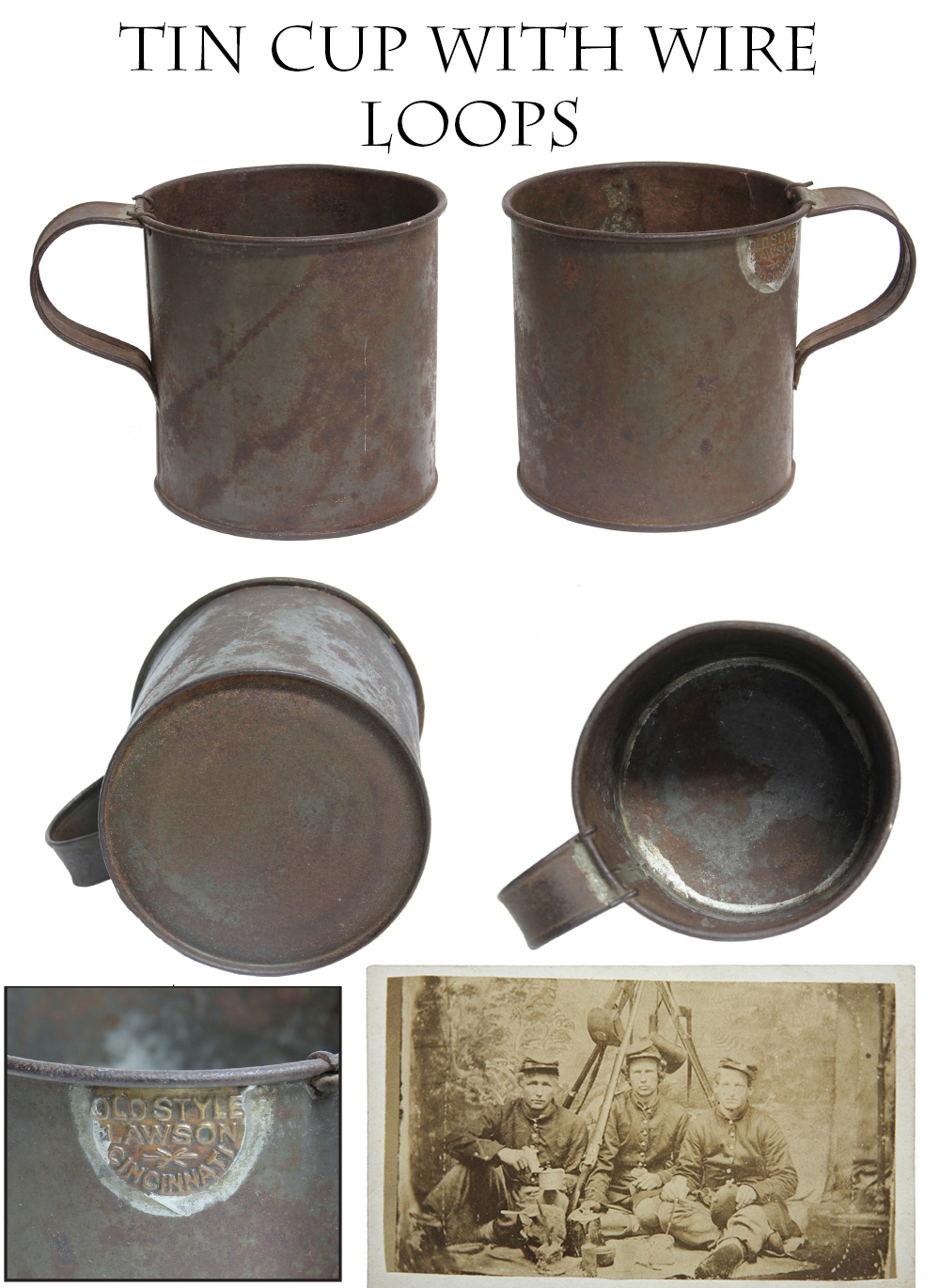
17-10-24.. CIVIL WAR STYLE MESS CUP …Standard Civil War style “four by four” mess cup made of tinned iron with a handle secured to the upper rim by wires so as not to come loose over a camp fire hot enough to melt solder. About half the tin remains, showing as gray against the brown iron underneath. Some roughness on the bottom, but no holes. Interestingly this has a small brass plate soldered to it reading “Old Style / Lawson / Cincinnati,” I am personally unfamiliar with this marking or this maker, and believe it may be post 1865 as the bottom is recessed. I note that the Horse Soldier Shop in Gettysburg sold an identical example for $225.00 which is still listed on their archives page. A nice example of a regulation army cup that might yield some interesting information on mess gear of the period but will also look great in a camp display. $125.00 Sold
Call us @ 419-842-1863

17-10-25… Gang Mold for Casting 44 Caliber Revolver Bullets: These gang style bullet molds were sometimes included in government contracts and shipped along with revolvers to troops in the field. They were also used by cartridge makers and arsenals. They are quite scarce as the bulk of army ammo was issued in the form of pre made skin cartridges, and the molds in the field were only kept on hand in the event that the ordnance department could not supply the pre-made nitrate infused paper skin cartridges. This one is numbered 373 on the handle ferrule and is complete with both original wood grips and sprue cutter. It would cast six .44 caliber conical balls at a time, enough for a single load of a Colt, Remington, or other military pistol of army caliber. A darn scarce accoutrement to display with Colts. $650.00 Sold
Call us @ 419-842-1863
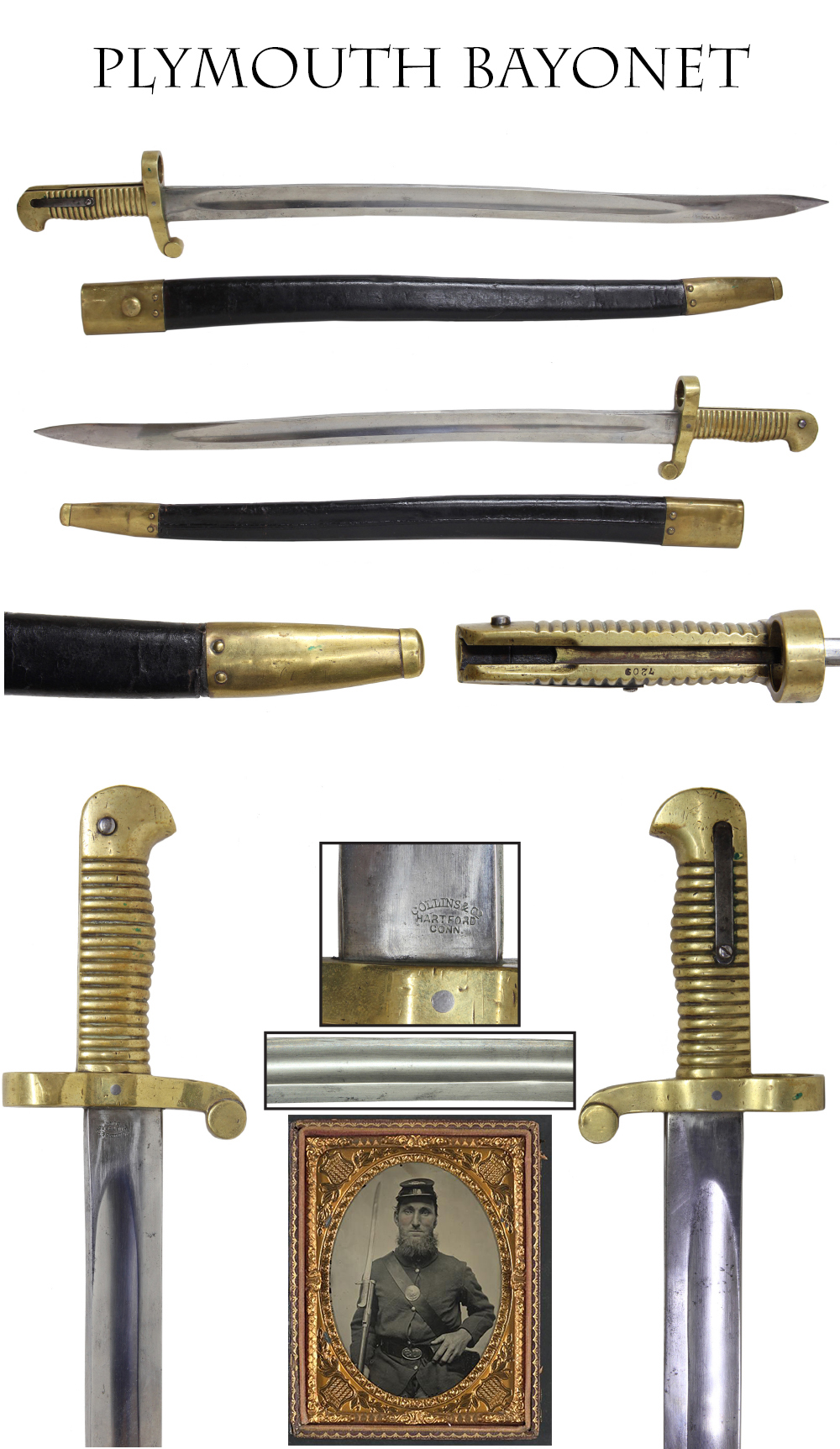
17-10-26…PLYMOUTH RIFLE SABER BAYONET & SCABBARD… Top notch example of the brass handled saber bayonet manufactured for the Plymouth Navy Rifle. Super condition bright blade with no nicks and good point, just a few very tiny gray spots here and there. Crisp “Collins & Co. / Hartford / Conn” maker’s stamp at the ricasso and serial number 7209 stamped on the upper side of the bayonet grip to match it to its rifle. This comes with its correct original scabbard- black leather with brass throat and drag, also in excellent condition, no bends or breaks and with excellent color and finish to the leather. One of the best examples of this pattern bayonet I have seen. You won’t be disappointed. I see Joe Salter’s web page has one with NO scabbard listed at $695.00. Here is the same bayonet complete with its’ original super scabbard. The complete scabbard is 100 times rarer than the bayonet. Bayonet WITH scabbard… $550.00 Sold
Call us @ 419-842-1863
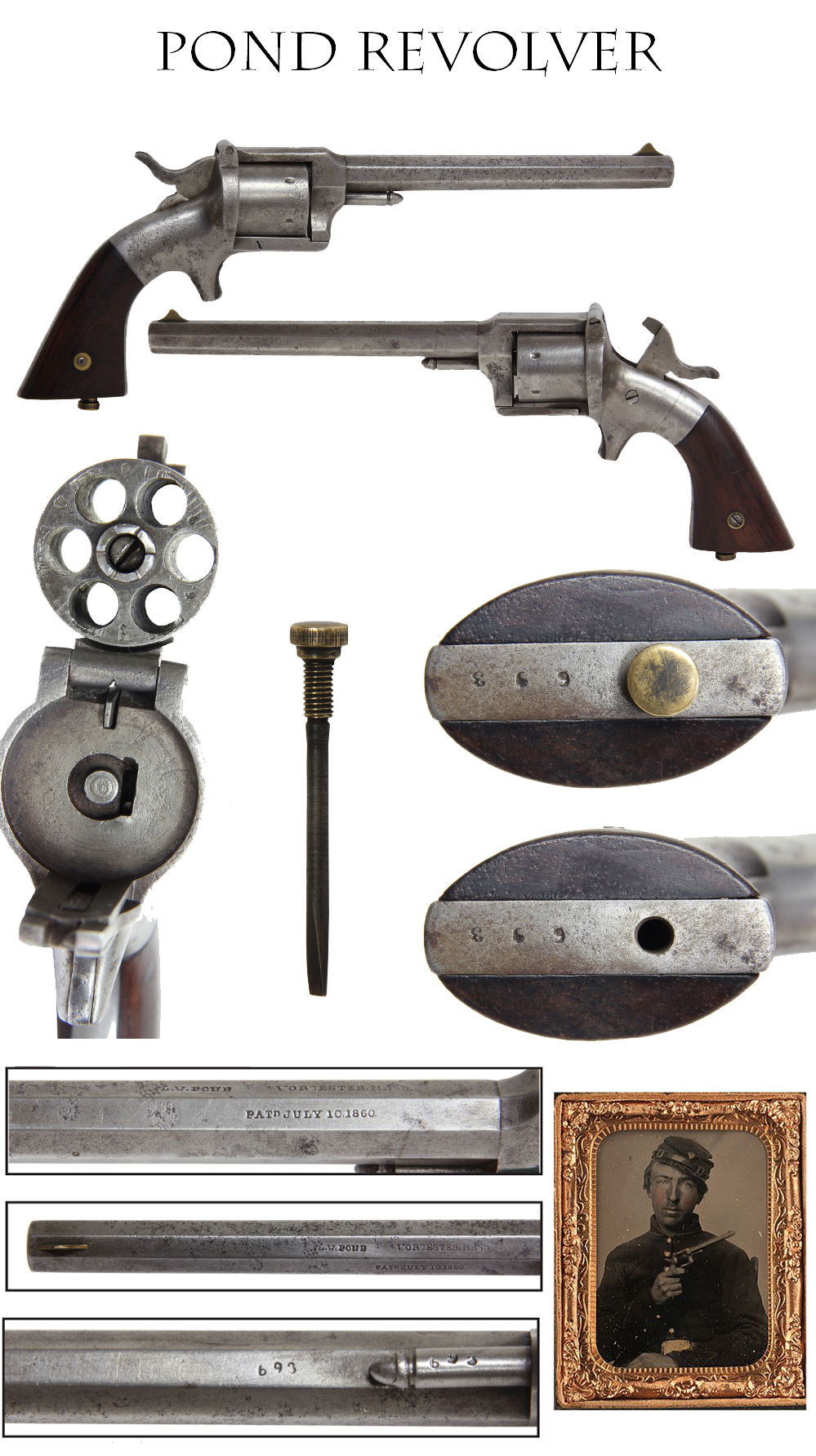
17-10-27…POND REVOLVER: We sold one of these two weeks ago, I then discovered this one on a pistol rack in our gun room…. the last one we have. Pond made several thousand of these .32 rimfire revolvers during the early 1860s before losing a lawsuit to Smith and Wesson for infringing on the Rollin White patent for bored-through cylinders. Production then ceased and the remaining inventory got Smith and Wesson markings added to them and the sale proceeds went to S&W. This is a nice example with a six-inch barrel and fairly early in the production run with a matching serial number of 963 that lacks any Smith and Wesson marks. Pond’s name and Worcester address are visible on the top barrel flat and a July 10, 1860, patent date is visible on the upper left flat. The metal is a smooth silver gray overall with just some scattered brown spots on the upper barrel flats and some scattered patchs of minute “salt and pepper” pitting that don’t stand out to the eye. The brass tipped screw driver is present in the butt. The grips are very good with a tight fit to the metal. The mechanics are pretty good with the cylinder being a bit finicky in terms of locking up. This a very elegant pistol with smooth lines and would make a nice addition to a Civil War officer’s display. $695.00 Sold
Call us @ 419-842-1863

17-10-28… SMITH AND WESSON NUMBER 2 ARMY REVOLVER…. 1860s revolvers firing the new fashioned self-contained .32 rimfire cartridge always had the advantage over percussion guns as the 32s did not require loose powder and percussion caps and were virtually immune to rough handling and dampness. The Smith and Wesson Number 2 Army was very popular with officers and some cavalrymen during the war. In addition no small number were carried by enlisted men who had a few extra dollars, not to mention early western travelers and gamblers such as Wild Bill Hickok. Even George Armstrong Custer had a pair and you can see one sitting on his wall shelf in the famous photo of his quarters at Fort Abraham Lincoln. This example is numbered 6407, putting it darn early in the Civil War. It is very attractive with generous traces of blue turned plum and with nice rosewood grips. Retains about 20-30 percent of the original blue (turned plum) remaining on the barrel , frame and cylinder. Very clear barrel address and cylinder patent dates. Generally smooth metal with underlying dull silver and plum brown coming up. Very slight traces of roughness at the forward edge of the cylinder and upper frame from firing. Mechanically perfect Indexes and locks up just like new. A solid early war S&W
$725.00 sold (PS Have another grey metal example in 50,000 serial range that we can sell for $550)
Call us @ 419-842-1863

17-10-29…SPENCER REPEATING RIFLE: Just as carried by Wilder’s Lightning Brigade and Custer’s Michigan Cavalry Brigade (aka Wolverine Brigade). Very nice condition example of the 1860 Spencer army rifle. Good action. Magazine tube, all bands, springs, sights and swivels in place. Good bore. No need for an introduction- these were important rifles in the history of American arms production. Spencer rifles led the way until October, 1863, when the carbines began to be issued. Even Custer’s Michigan cavalry initially had the long infantry rifle and Wilder’s lightening brigade regiments carried the long rifles on horseback as well. Custer got the shorter carbines in late 63 and 64. This one is serial number 23554, likely making it one of the 1,868 army rifles manufactured in early May, 1864, and intended for Massachusetts, but diverted to the Federal government (Marcot 70-71, and 302) to meet the pressing demands of field service. The wood stocks are very good, with good color and tight fit, just some minor handling dings and two scratches on the left butt flat. Metal is a smooth silver gray overall with some faint case color showing on the hammer and lock. Serial numbers, manufacturing and patent stamps are sharp with just a little rubbing on the lower right of the patent date on the upper receiver. A number of infantry regiments received these weapons and they were formidable in open battle and up close. A member of the 37th Mass saved his own life by chambering a new round with one hand while a Confederate held him pinned to the ground with a bayonet. (Now that’s presence of mind.) The most famous person to use the Spencer rifle was Abraham Lincoln who test fired one on the lawn of the White House, and found it a worthwhile arm. $2,950.00 sold
Call us @ 419-842-1863
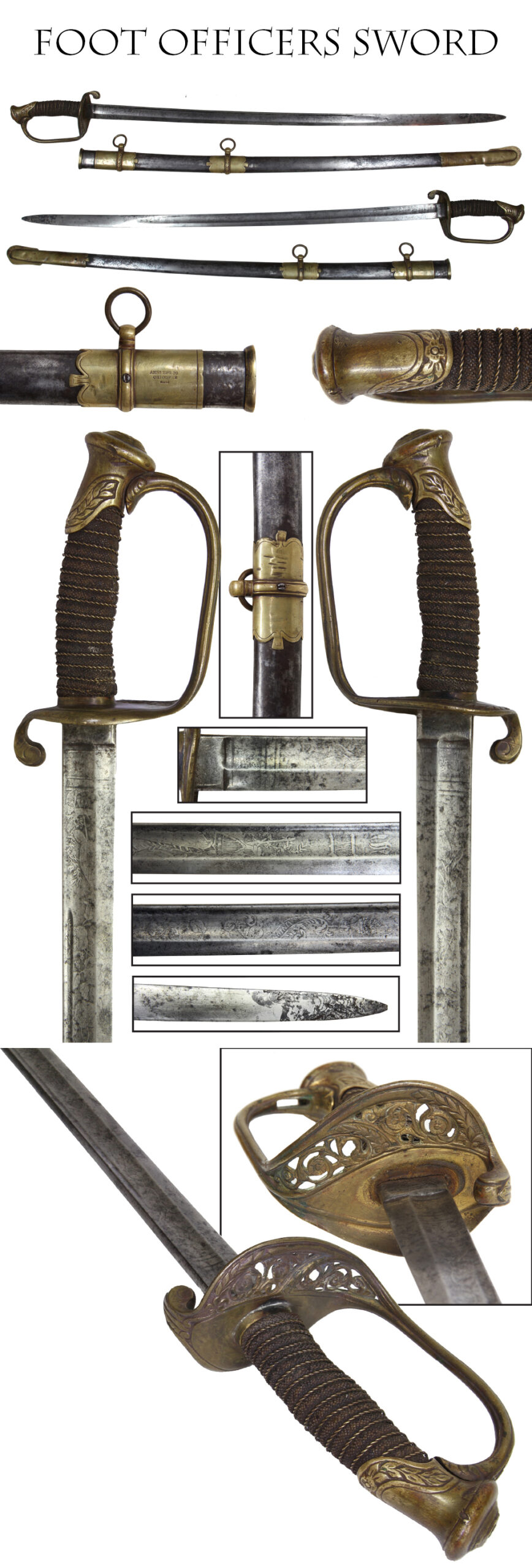
17-10-30…FOOT OFFICER’S SWORD WITH STEEL SCABBARD…. These foot swords with brass mounted steel scabbards are quite scarce. 95% of them left the factory with leather sheaths & brass mounts. The U.S. army adopted this pattern of sword in 1850 for “foot officers:” ie: lieutenants and captains of infantry, who served on foot and in the line of battle with their men during action. Modeled on a French pattern, as most everything military was at the time, these swords have a robust blade, brass hilt cast with floral motifs, and a grip wrapped with sharkskin or ray skin and bound with twisted brass wire. By regulation the line officer’s sword had a leather scabbard, but sword makers also offered brass mounted steel as we see here. This sword & scabbard is a marriage of a Christopher Roby Chelmsford, Mass. sword with an Ames Chicopee, Mass. scabbard. Whether the marriage took place in 1862 or 1962 I cannot say for sure… but the patina matches perfectly on both elements, the blade fits perfectly, and I found this sword just the way you see it. Our scabbard has a nice Ames maker’s stamp on the upper brass mount. The sword itself has a matching medium aged patina to the brass, a full sharkskin wrap with some very minor wear, and full wire. The blade is a mix of silver and darker gray, making the profuse etching of vines, leaves and patriotic motifs, including a shield, flag, a U.S., and a ribband reading “UNION” visible if not vibrant. The Roby firm name is faint but visible. The very tip of the point has a chip and there are some darker areas for the first inch or two back from there. This is a good solid example, with the blade pad still on the underside of the guard. The sword is worth $450 The scabbard is worth $450…. Take both pieces for $695.00
Sold
Call us @ 419-842-1863
Layaways are Welcome
Need to split your order into multiple payments? No problem! A simple 20% earnest money deposit will hold your item for you.-acf
You can then pay it off in easy installments that fit your budget.
Read Terms Here
Items to Sell? Contact Us
I am always interested in buying ANYTHING from the American Civil War… Guns, Swords, Civil War Muskets, Knives, Uniforms, Flags, Medals, Badges, Diaries, Letters, Autographs, Buttons, photographs, tintypes, daguerreotypes, Insignia, Camp Items, Battlefield Relics, canteens, Drums, Etc… Call 419-842-1863 and ask for Dave Taylor.

